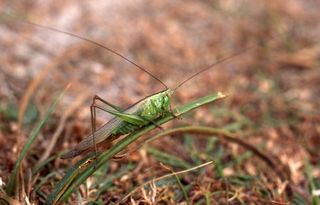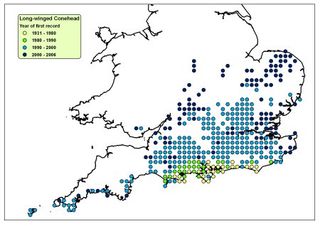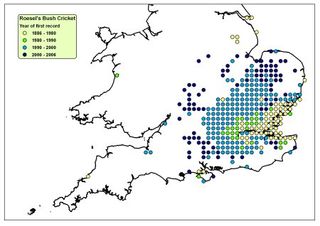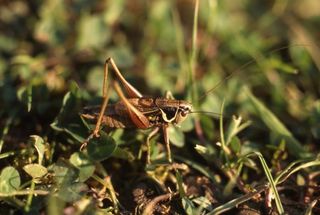Climate change causes increase of grasshoppers and crickets
Findings of a new survey reveal species of grasshopper and cricket that are thriving in now-warmer areas of Britain

Climate change is causing an increase in numbers of several grasshopper and cricket species. According to research from the Centre for Ecology & Hydrology (CEH), the warmer weather in Britain has led to rise in numbers of species, such as the long-winged conehead and the Roesel’s bush cricket, in more northern areas.

Long-winged conehead Credit: Peter Sutton
The long-winged conehead, a bush cricket species, which first appeared in Britain in about 1945, was confined to the South Coast until the 1980s, but can now be found north of Leicester. Data shows that it has moved more than 150 miles in the past 20 years.

Spread of the long-winged conehead Credit: Centre for Ecology and Hydrology
Similarly, the Roesel’s bush cricket was mainly restricted to the Thames and Solent Estuaries until the mid 20th century, but is now spreading across south and central Britain, migrating more than 50 miles over the past 20 years.

Spread of the Roesel's bush cricket Credit: Centre for Ecology and Hydrology
The most common insect species in Britain are the ones that have increased most in number, as more of these cold-blooded species move into warm areas up north; there are some rarer species, such as those that use warm sand dunes for habitats, that are unlikely to increase in the same way.
Sign up for the Country Life Newsletter
Exquisite houses, the beauty of Nature, and how to get the most from your life, straight to your inbox.
Dr Peter Sutton, a science teacher from Bedfordshire and a leading authority on grasshoppers and crickets, said: ‘The remarkable range expansions observed over the past two decades have shown, unequivocally, that where species are capable of exploiting new habitats, they have done so.
‘Moreover, the profound changes that we have observed are clearly only the tip of the iceberg.’
The findings come as a result of the CEH’s new web-based monitoring scheme, which encourages the public to record sightings of the 27 native species of Orthoptera (grasshoppers and crickets). This follows the success of the website tracking the rise of the invasive harlequin ladybird.
Dr Helen Roy of the CEH, who has been involved with both websites, said: ‘The harlequin survey was a great way to get more people involved in recording wildlife, and we receive very high-quality data.
‘We now want to expand, and we’ve chosen grasshoppers and crickets because they are both charismatic and also some species are showing evidence of range expansion within the UK.’

Rosel's bush cricket Credit: Peter Sutton Björn Beckmann, a researcher on the project, said: ‘Our findings on the correlation between changing weather patterns and insect species expansion are reflected by those in the rest of central Europe, so this isn’t just a local phenomenon.
‘Defra’s latest UKCP09 predictions suggest that climate change will continue to affect Britain’s weather patterns over the next 100 years, so we expect to see the Orthoptera species expansion continue.
‘This increase can be viewed as a positive change. Grasshoppers are vegetarian, so they’re unlikely to adversely affect the numbers of other species, and, in fact, will provide more food for British spiders and birds.’
If you see a grasshopper or a cricket, report it to the CEH website at www.orthoptera.org.uk
For help in identifying what you see, use the Field Studies Council insect chart
To comment on this article, use the comment box below, or email us at clonews@ipcmedia.com. Read more about the countryside
For more news stories like this every week subscribe and save
-
 Brockfield Hall, the great Yorkshire house that's gone from Regency mansion to modern family home
Brockfield Hall, the great Yorkshire house that's gone from Regency mansion to modern family homeBrockfield Hall in North Yorkshire is the family home of Charlie Wood and Hatta Byng, editor of House & Garden, who have transformed it since they came here in 2020, winning multiple awards in the process. John Martin Robinson reports on the restoration project that revived this compact Regency house as a modern family home. Photographs by Paul Highnam for Country Life.
By John Martin Robinson Published
-
 Barbour’s heritage jackets get a floral makeover courtesy of Erdem
Barbour’s heritage jackets get a floral makeover courtesy of ErdemUtilitarian outwear has taken the fashion world by storm and now Britain's world-famous wax jackets are getting in on the act, inspired by some of our greatest countryside icons.
By Amy de la Haye Published